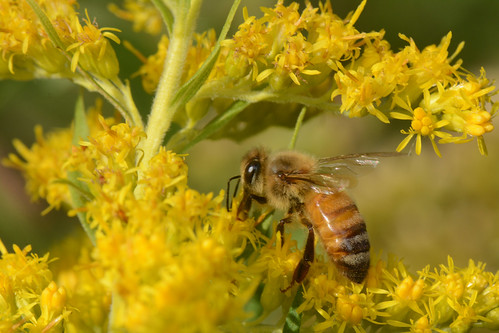
Goldenrod pollen is a key protein source for honey bees in the fall. Photo by David C. Smith, Williams College
All this month we will be taking a look at what a changing climate means to Agriculture. The ten regional USDA Climate Hubs were established to synthesize and translate climate science and research into easily understood products and tools that land managers can use to make climate-informed decisions. The Hubs work at the regional level with an extensive network of trusted USDA agency partners, technical service providers, University collaborators, and private sector advisers to ensure they have the information they need to respond to producers who are dealing with the effects of a variable climate. USDA’s Climate Hubs are part of our broad commitment to developing the next generation of climate solutions, so that our agricultural leaders have the modern technologies and tools they need to adapt and succeed in the face of a changing climate.
Honey bee health and climate change would both rank high on anyone’s list of hot topics in agriculture these days.
Lewis H. Ziska, an Agricultural Research Service (ARS) plant physiologist, with what is part of the Northeast Climate Hub in Beltsville, Maryland, knows this. He also knows that any study involving both honey bees and climate change should be carefully conducted and cautiously interpreted. Ziska has been studying the effects of climate change on plants since 1988. He has been focusing on how rising atmospheric carbon dioxide (CO2) levels accompanying climate change are affecting a wide range of plants—from important food crops to noxious weeds.
So Ziska and his colleagues were extremely thorough in their analysis of how rising CO2 levels are affecting the pollen of Canada goldenrod (Solidago Canadensis), the most widespread source of fall protein for honey bees. It’s considered crucial in helping honey bees survive through winter.
To confirm the honey bees’ fall feeding habits, the researchers went out to a field in the Berkshires, identified the number of goldenrod plants there, and then counted honey bee “visits” to each plant. To mimic the effects of climate change over the past 150 years, they exposed goldenrod growing in chambers of undisturbed soil in Texas to graduated levels of CO2. To get an historical perspective, they analyzed goldenrod pollen from across the United States collected as far back as 1842 and stored at the National Museum of Natural History.
Study results showed that the pollen protein levels have declined by up to a third since the 1850s, when atmospheric CO2 levels began rising, and that the most serious declines have occurred since 1960, when CO2 levels began rising dramatically. It was the first study to document the effects of rising CO2 levels on honey bee diets. The results appeared in Proceedings of the Royal Society B.
Scientists say the results are consistent with the rules of basic plant biology. Plants exposed to higher CO2 levels produce more starch and sugar but less protein. Scientists have consistently found the same trend—diminished protein content with increased CO2 levels—in studies of human food crops. In fact, it is precisely the trend in food crops that prompted Ziska to conduct his study.
But there could be a silver lining. The results may help scientists address increases in mortality rates in managed honey bee colonies by coming up with ways to improve diets and ensure that the bees get sufficient protein in the fall to survive through winter. Ziska also is working with other scientists on ways to adapt food crops, such as wheat and rice, to climate change by using traditional breeding techniques to tap into the genes that make their wild, weedy relatives more adaptable to rising CO2levels.
“We have a lot of work ahead of us, but I think people are more aware of the challenges being presented by climate change, and that’s an important step,” he said.
No comments:
Post a Comment
Note: Only a member of this blog may post a comment.